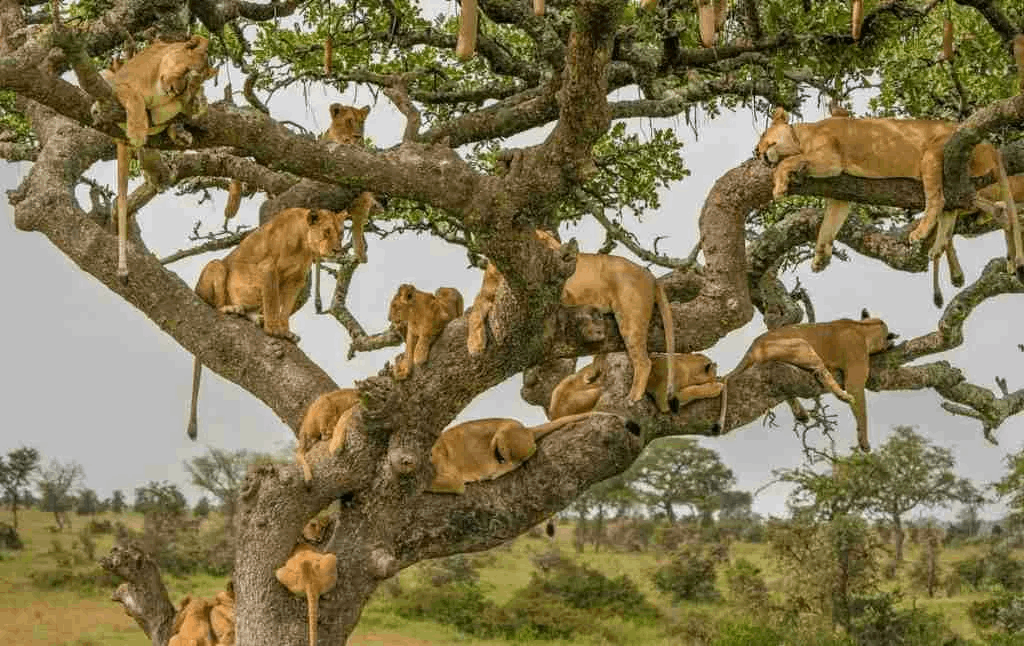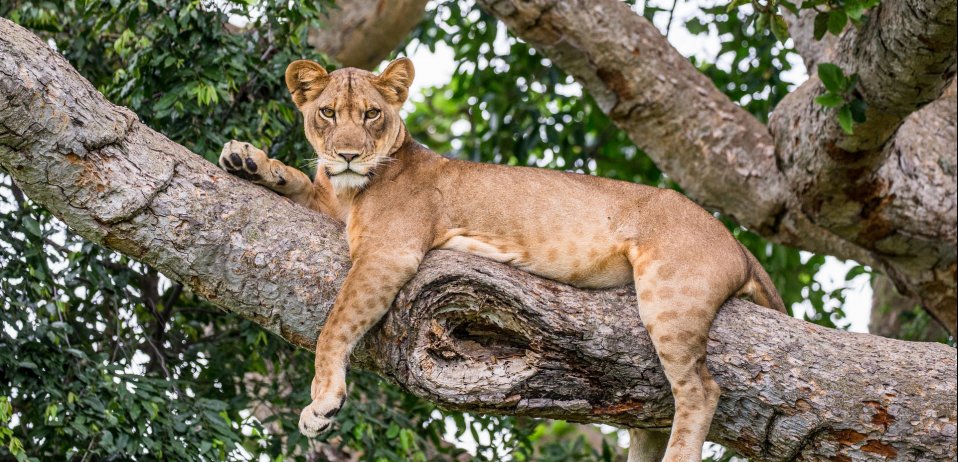Ishasha tree climbing lions
Ishasha tree climbing lions : The southern portion of Queen Elizabeth National Park’s Ishasha Sector is home to tree-climbing lions. Lions do not typically climb trees as a habit.
The only park in Uganda where tree-climbing lions can be seen is Queen Elizabeth. People have reported seeing lions in South Africa and Kenya, but these reports don’t seem to be as convincing as those from Queen Elizabeth Park because the lions they see are usually young animals playing around tree branches.

Aside from Lake Manyara in Tanzania’s neighboring country, lions are present in other national parks such as Murchison Falls, Kidepo, and others, however they do not climb trees like those found in Queen Elizabeth National Park.
It is common to see tree-climbing lions lounging around in the trees, and some of them even nod off from up there. Research reveals the specific reasons why lions in these Ishasha savannah plains ascend up in the tree branches:
• Running away from bites from insects. The grounds become overrun with tsetse flies during the rainy season, which bites all of the wild animals, including lions. The lions take cover from the numerous insects on the property by running to the tree branches as a result.
• Getting away from the ground’s heat. The savannah typically experiences temperatures above 28 degrees Celsius, or 80 degrees Fahrenheit, during seasonal changes. The cats find the ground to be very hot due to this heat. Thankfully, they locate somewhere to cool off in the tree branches after their search.
• Cool vista of these large animals’ magnificent meal. It’s evident that a high-level vision is wider than what you would expect to see. When antelopes are feeding in the meadows, lions would scale tree branches to get a look of their prey.
The lions in Queen Elizabeth National Park’s Ishasha Sector in the south are “tree climbers” for the reasons mentioned above.
The broad-branched (candelabrum) trees at Queen Elizabeth National Park are a favorite habitat for climbing lions. Acacia and sycamore fig trees are two examples of these trees. These are the right kind of trees since they are sufficiently wide to offer a peaceful, roomy area for resting and to serve as a good cover for lions during the rainy season.

Rich in wildlife, Queen Elizabeth National Park is home to a variety of species, including candlestick thorns, humid rain forests, and Savannah vegetation, which is ideal for most species, including warthogs, antelopes, and Ugandan kobs. These animals can be seen roaming around the park’s lakes, ishasha sector, kasenyi plains, kazinga channel, and chimpanzees at Kyambura George, among other areas.
The sycamore fig and acacia trees are the common trees that the tree-climbing lions typically scale before sunrise. The male lions belonging to Queen Elizabeth’s pride have black manes.
You won’t forget your once-in-a-lifetime experience seeing Queen Elizabeth’s rare and exceptional lions, especially if you capture many of pictures of them whether they’re hunting or just lounging in the tree branches.
The sycamore fig tree is beneficial to the tree-climbing lions because it offers them enough cover from the heat and during the rainy seasons.
Why is Queen Elizabeth National Park the best location for lions that climb trees?
The southern region of Queen Elizabeth National Park (ishasha) is well-known in the global tourism business because of tree-climbing lions. Thousands of visitors come to the national park each year from all over the world to see the tree-climbing lions. They provide travelers visiting East Africa with an unforgettable experience and are a major draw.
Because tree climbing lions are uncommon, visitors may conclude that the idea that there are tree climbing lions in Africa is unfounded. This is especially true when it comes to Lake Manyara in Tanzania. In contrast, it is important for visitors to Ishasha in Queen Elizabeth National Park to witness a considerable number of them.
When visitors arrive at Queen Elizabeth National Park, they are left speechless and in complete awe by the enigmatic behavior of the cats—tree climbing lions—who effortlessly scale the tallest trees and give each other hugs. More than fifty lions are known to be spotted napping in the woods by tourists.
Upon spotting the tree-climbing leopards during a wildlife drive in Uganda’s Queen Elizabeth National Park, you will undoubtedly verify the special quality of these large cats, known as ishasha.
After a long day of hunting, they hung idly in the tree branches to rest and properly digest their food. They are also seen looking excitedly at the tiny creatures that are foraging on the ground. As a result, the trees provide the lions with a comfortable lobby as well as a place to watch on potential prey.
Should we refer to these felines and lions as the “king” of the African jungles?
The increasing number of people living in and around Ishasha poses a serious threat to the tree-climbing lions that live there. As an illustration, on April 10, 2018, eleven dead lions were discovered in Ishasha. They are said to have had pesticide poison in their systems when they were discovered.
The population of these exceptional, gifted tree-climbing lions in Queen Elizabeth National Park is declining due to a number of reasons, including natural mortality and the dominant male’s slaughter of calves, among others.
Even though these lions are in risk of extinction, travelers continue to be drawn to this African forest to see them. They continue to be proud of their historical status as “the king of the jungle,” and nothing will ever change that.
In addition to the unusual tree-climbing lions, Queen Elizabeth is home to several of Africa’s large cats, including leopards, as well as antelopes, elephants, buffalos, hyenas, and many other creatures.
The remainder Along with the stunning kyambura George, where chimpanzees can be trekked, Queen Elizabeth offers breathtaking scenic views of a true wilderness, ranging from the imposing Ruwenzori mountains, also known as the “mountains of the moon,” to the magnificent crater lakes that surround the park. These lakes are connected by the lively Kazinga channel, which is streamlined with hundreds of hippos, crocodiles, and elephants playing with water at midday. Visitors can also visit these remote fishing villages, engage with the locals, enjoy local dances, and browse the gift shops to find locally crafted items to bring back home.



